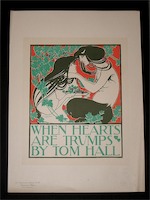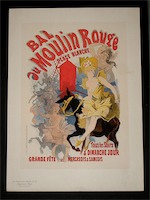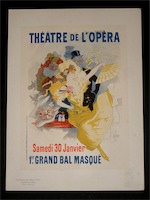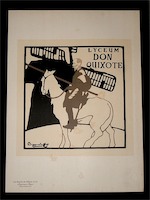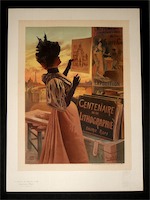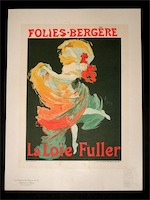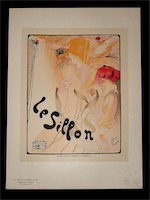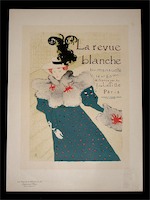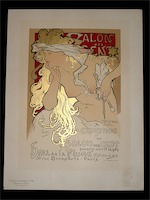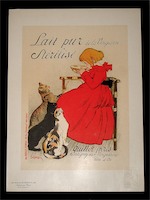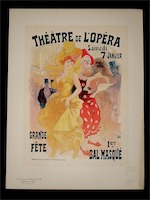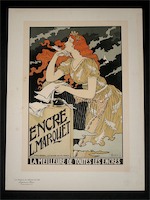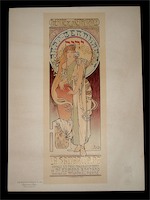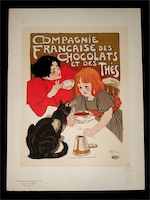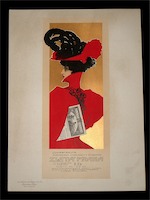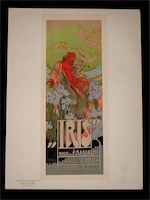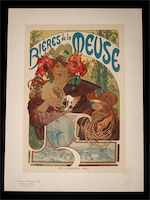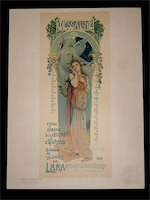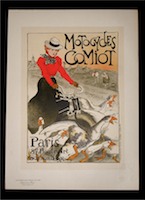Vintage Posters
Size: Please read description - Original Lithographs
Please scroll down for bibliographic information
"From the years 1890 to 1900, Europe and America were in a frenzy over a new form of advertising, which was also a new form of art: the illustrated color advertising poster. Gone were the drab streets and boring broadsides. The boulevards of Paris, the tiny streets of Belgium and Holland, the otherwise solemn squares of London, and the shop windows of America proliferated with colorful images, a veritable public poster parade, created by some of the most talented artists of their times." (Fusco p.xiii)
"All the evidence that has been gathered indicates that towns (in the middle of the 19th century) were covered with posters having one point in common: an absolute lack of artistic value. The poster existed but the art of advertising had not yet been born. In order for it to develop, in order for it to be recognized, the intervention of an artist of talent was necessary. Furthermore, this artist had to be an accomplished lithographer in order to arrive at a mastery of color. It is Jules Cheret, who is recognized, rightly, as the Father of poster art (designing over 1000 posters). From 1860, he gave the world the final impetus which allowed it to establish itself in France and the world over...he undeniably pointed the way for all Europe." (Weill p. 24,28)
"All the evidence that has been gathered indicates that towns (in the middle of the 19th century) were covered with posters having one point in common: an absolute lack of artistic value. The poster existed but the art of advertising had not yet been born. In order for it to develop, in order for it to be recognized, the intervention of an artist of talent was necessary. Furthermore, this artist had to be an accomplished lithographer in order to arrive at a mastery of color. It is Jules Cheret, who is recognized, rightly, as the Father of poster art (designing over 1000 posters). From 1860, he gave the world the final impetus which allowed it to establish itself in France and the world over...he undeniably pointed the way for all Europe." (Weill p. 24,28)
The great artists of Paris led the way in the poster movement. Their designs were influenced, in part, by Japanese woodcuts. This notable group headed by Cheret and including the great masters, Steinlen, Grasset, Bonnard, Willette, Forain, and the most famous artist of them all Toulouse-Lautrec. Their designs were decorating the walls of their city with lithographic masterpieces and bringing light and gaiety to a workday world. The influence of these artists spread internationally, and many of their designs have never been excelled.
Among the earlier American designers the names Rhead, Bradley, Parrish, Dow, Woodbury and Penfield stand out. In England artists including Greiffenhagen, Morrow, and Price had begun their contributions to the field, while artists like Dudley Hardy appealed alike to the critic and the man in the street by his bold groupings and strong colour arrangements. As well The Beggarstaffs, consisting of Nicholson & Pryde, perhaps the most influential graphic designers of all time, virtually created the modern poster, with clear outlines and large areas of flat colour.
Names like Mucha "The Father of Art Nouveau," and Cappiello "The Father of Modern Advertising," as well Misti, Pal, Hohenstein, Henri Meunier, De Feure, and so many others were soon added to this growing list of great poster designers whose work can now be found on display in major museums and private collections around the world.
Among the earlier American designers the names Rhead, Bradley, Parrish, Dow, Woodbury and Penfield stand out. In England artists including Greiffenhagen, Morrow, and Price had begun their contributions to the field, while artists like Dudley Hardy appealed alike to the critic and the man in the street by his bold groupings and strong colour arrangements. As well The Beggarstaffs, consisting of Nicholson & Pryde, perhaps the most influential graphic designers of all time, virtually created the modern poster, with clear outlines and large areas of flat colour.
Names like Mucha "The Father of Art Nouveau," and Cappiello "The Father of Modern Advertising," as well Misti, Pal, Hohenstein, Henri Meunier, De Feure, and so many others were soon added to this growing list of great poster designers whose work can now be found on display in major museums and private collections around the world.
